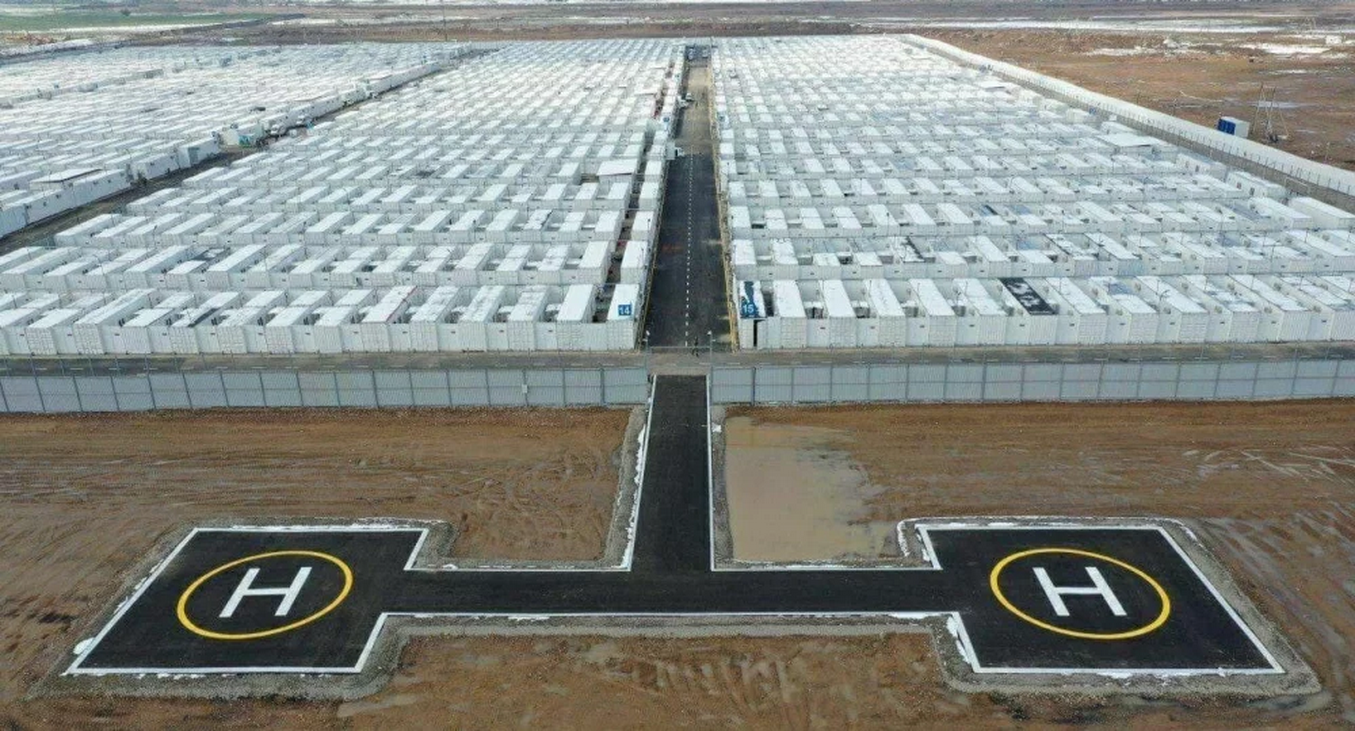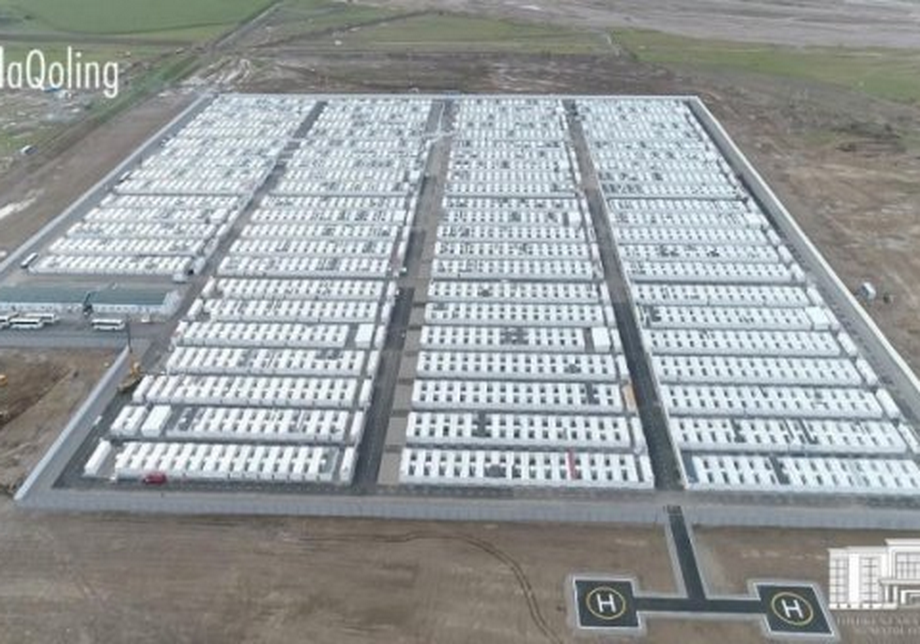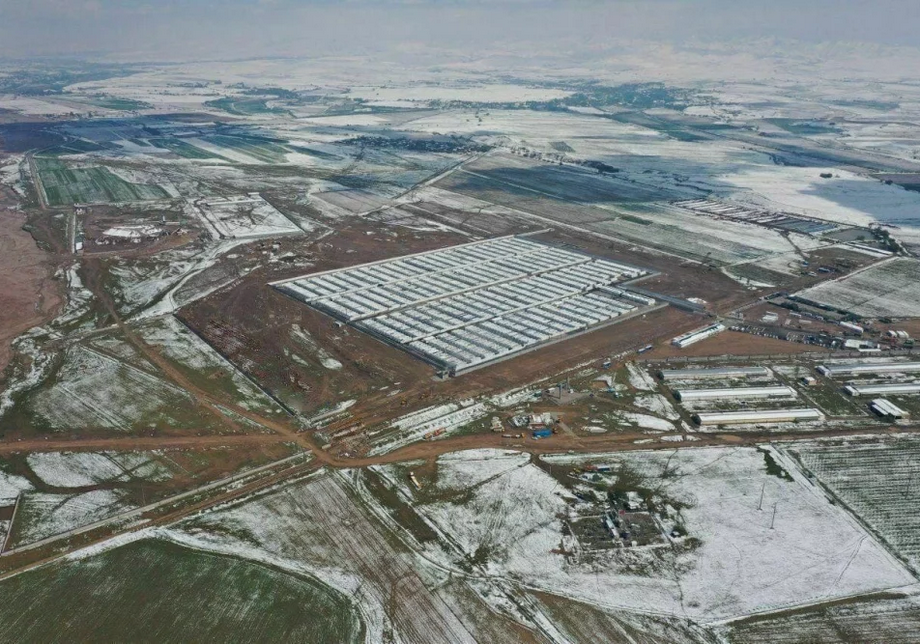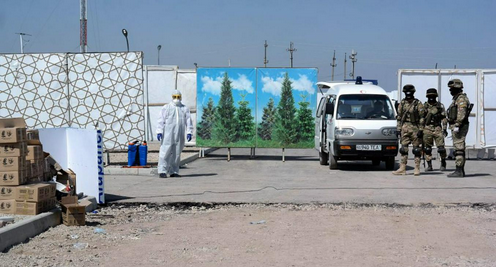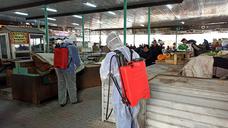In a previous article on this site, we have highlighted how one key factor behind the relatively low number of COVID-19 cases in Kazakhstan, Kyrgyzstan and Uzbekistan has been extensive quarantining of all those suspected of having been in close contact with infected individuals and all those returning from abroad. Hundreds of thousands of people have been quarantined since the pandemic began, many in their own homes, but large numbers too – including all returnees from abroad – in specially-designated quarantine facilities.
In our last article we covered the situation at the start of the epidemic in Kazakhstan. The Central Asian country that has made the most extensive use of quarantines, however, is Uzbekistan. As early as 11 April, 200,000 individuals were reported to have been placed in quarantine, 35,000 of them at quarantine facilities. On 7 June, the Uzbek health ministry stated that the total figure had reached 441,600. In recent weeks, numbers of those held in guarded quarantine sites has hovered around 20-25,000, with upwards of 1,000 people leaving and joining these facilities each day.
Uzbekistan has perhaps also taken the most innovative approach to finding space to house such large numbers of people. Using converted shipping containers as accommodation units, over a period of just five days in mid-March the Uzbek authorities constructed what was to become a 10,000-person-capacity quarantine camp near the village of O’rtasaroy, 25 km from Tashkent, to house Uzbek citizens returning from abroad. An extension to the camp was said to be planned to double its size and a smaller facility has been built outside of Samarkand. With 100,000 Uzbeks recently stated to be on a waiting list for state-organised charter flights back to the country – not to mention those crossing the border from neighbouring states – Uzbekistan looks set to need this capacity for some time ahead.
To give an idea of what life was like for those who spent two (or more) weeks of their life at the O’rtasaroy facility and elsewhere, here we summarise two articles on the camp – one early report (in Russian) by RFE/RL’s Uzbek service Ozodlik from 16 April, and one more recent article by Svetlana Bagramova on our Russian site, while adding a little extra testimony from Uzbek quarantine residents on Facebook.
The container camp
The first impression many residents of the container camp at O’rtasaroy recall is their surprise on arrival. After long flights from Moscow, Paris, Berlin and elsewhere, returning travellers are loaded onto waiting buses by hazmat-suited individuals immediately upon disembarking the plane. After an hour or so’s wait for everyone to be registered, the convoy sets off – through Tashkent, out into the countryside, and along a dirt track, before arriving at the strange sight of a ship-container quarantine zone built for 10,000 people. Mansur and his wife Zebo, interviewed by RFE/RL, were among the first to stay at the camp after its hasty construction. The couple flew in to Tashkent from Moscow on 22 March. Both requested that journalists alter their real names – in this they were far from alone.
“From the outside the container camp looks like a cargo terminal. There are trailers everywhere, with people living inside them. I was taken aback when I saw it,” said Mansur.
“It’s an amazing idea, that’s for sure. The size is incredible, it takes your breath away. When I saw this ‘city’ I was silently stunned. It’s huge,” wrote Facebook user Teya.
Anastasia, who spoke to Svetlana Bagramova, was also part of the first wave. She flew in from Moscow on 26 March with her young son and arrived in the camp when much of it was still under construction. “It was night, we were tired, we drove through some fields, and suddenly – people. Lots of people. Obviously construction workers and camp employees. Even though it was around 1 am, people were busy working. It was incredibly touching when they started to wave to the approaching buses. They were waving, clapping, whistling, welcoming us. It gave me goose bumps,” she said.
Inside, the containers all have the same standardised design: each container is divided into two parts, with two sets of bunk beds (i.e. four beds) in each one. Since residents are supposed to remain in isolation and not go out onto the streets of the camp unless absolutely necessary, the containers are equipped with bathrooms, with a wash-basin, a mirror, a toilet and even a shower. Pictures taken from above also show small open-air areas between the containers which residents have access to. Sheets, blankets, pillows and towels are provided. The containers are fitted with air conditioning, a TV, a telephone and an electric kettle. Drinking water is supplied in refilled plastic bottles. Food, of course, is also provided – made by the camp’s 100 cooks – and was left each mealtime outside the door. 3,000 people in total are said to work at the site.
-
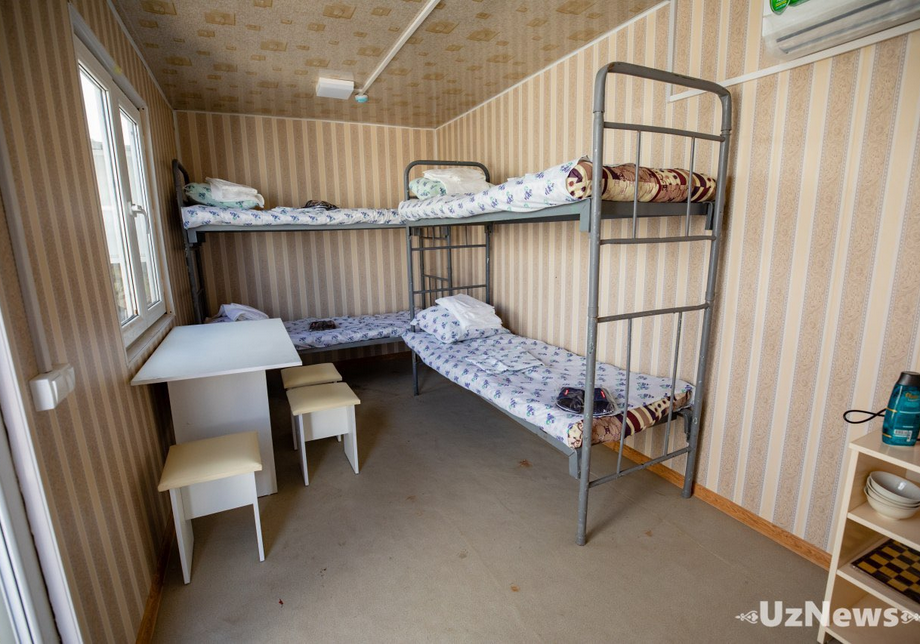
Inside one of the containers
Photo from UzNews -
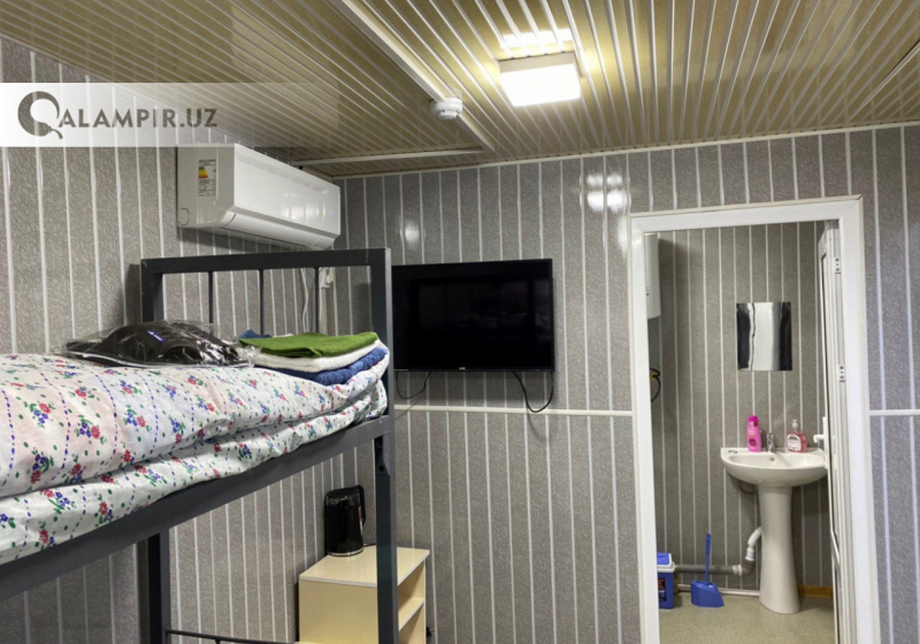
Inside one of the containers
Photo from Qalampir.uz -

Laboratory under construction at the O'rtasaroy camp Photo from Qalampir.uz
Photo from Qalampir.uz -
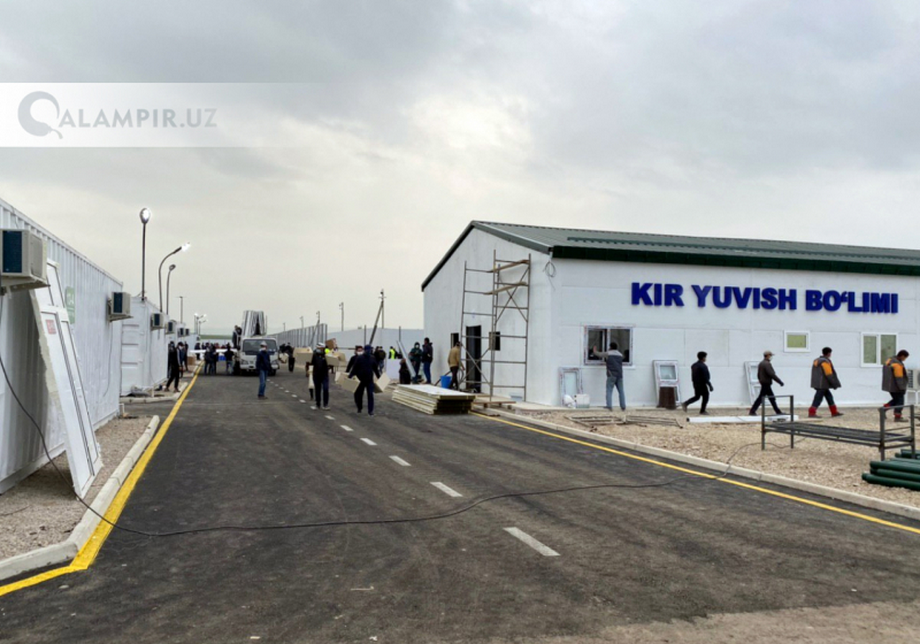
Laundry facility under construction at the O'rtasaroy camp
Photo from Qalampir.uz -
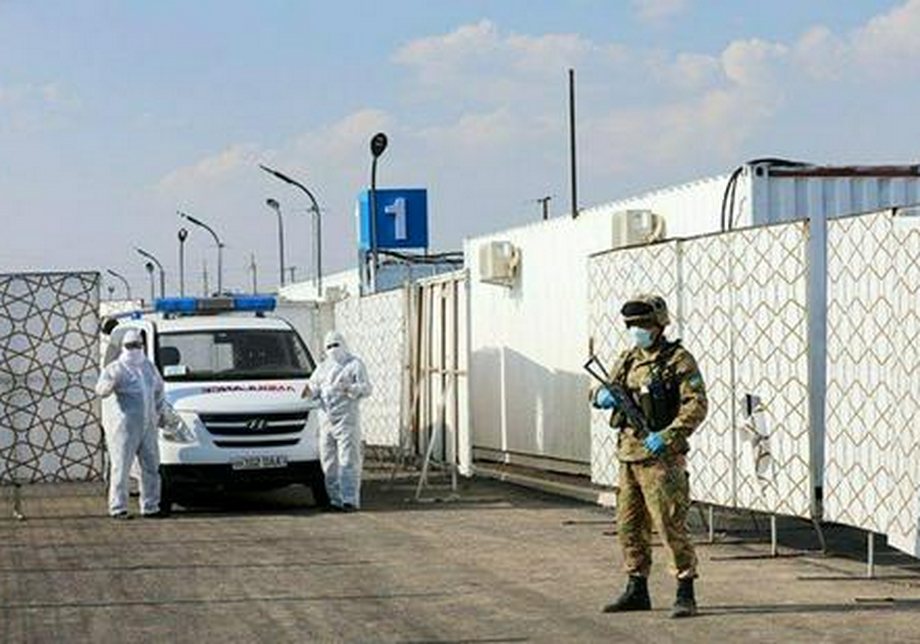
An armed guard at the O'rtasaroy camp
Photo from the press office of the Tashkent regional administration -

Food at the camp
Photo from the press office of the Tashkent regional administration
The fact that four people had to share a room was not to the liking of all. As Uzbek rock musician Grigori (Grishan) Danielyan, who spent 16 days at the camp, put it on his Facebook page: “If one of the four has the coronavirus, then all four are going to get ill. Fun.”
Coronavirus tests, Svetlana Bagramova writes, are conducted twice – once upon arrival and then again just before release. Temperatures are measured each morning. If the second test comes back positive then the individual in question is whisked off to the infectious diseases hospital, and his roommates are left to while away another 14 days in quarantine.
While pictures of the rooms look surprisingly comfortable, many people reported that not everything in them worked as planned. According to some accounts, taps churned out sand along with hot and cold water. Others reported that heating was a problem. Back in March, night-time temperatures outside the containers could fall close to zero. In theory, heating was supposed to be provided by the air-conditioning units, but some of them did not work properly.
“At the start of April it snowed,” said Mansur. “We were totally frozen in the containers. We had to warm ourselves by pouring hot water into the plastic bottles. There were heaters in the camp, but not enough for all who needed them. Cold wind blew through the cracks and gaps.”
“On the fifth day of severe cold, with chattering teeth, we managed to beg our way to a heater,” Teya recounted. “Which, however, did not save us from the water coming through the cracks – it poured in from everywhere. From the windows, the doors, from above, from below, from the sides. In the end they sealed everything with foam. On the 14th day. They can build a camp in 5 days, but they can’t fill some cracks with foam!”
Others too complained of cold and wet coming in through un-sealed holes in the roofs and walls and poorly-closing doors. Svetlana Bagramova relates the story of one elderly Uzbek woman who had been placed in the camp after returning from a course of chemotherapy abroad. In her weakened state, the woman was forced to mop ice-cold water from the floor every half an hour. During the frequent spring rains, water seeped in through gaps in the doors and window seams.
One thing camp residents generally agree upon, however, is that there was no problem with the food. “They gave us potatoes, rice, meat, pasta and buckwheat. We always had sugar, tea and biscuits in the containers. They placed our meals in disposable plates and bowls by the entrance to the container and we always ate inside,” Zebo said.
Many also appreciated the way demands for isolation were strictly enforced and followed. Indeed, in spite of the discomforts, most residents felt that the basic idea of the quarantine camps was, as Danielyan put it, “entirely correct”.
“How else are you going to isolate such a vast number of people?” Mansur and Zebo ask. Though they add that “it would have been better if it hadn’t been so cold inside the rooms”.
No phones
Some residents were a little more indignant about their experiences at O’rtasaroy, however. Kamol (pseudonym) had been transferred there after already having spent time in quarantine in a sanatorium in Tashkent. While the food and isolation measures were far better at O’rtasaroy, the container camp left him with a number of other complaints.
“For almost 24 hours there’s been no water coming out of the taps. And the last time they brought drinking water was three days ago. (...) For the first few days in the containers they didn’t even give us teabags, they told us to drink hot water. Where one group of women were staying, the air conditioning didn’t work. It started snowing, they went and asked for help but all that happened was that they were locked in their containers and ignored. Sometimes they come with drinking water, sometimes they don’t for several days. We cut up empty bottles, put them on the roof and collected rain water so that we at least had something to wet our lips with. We filmed it and sent the clip to friends in Tashkent. But things got even worse after that – they came to our container and demanded that we hand over the mobile phone, threatening us that they could have us put in jail for three years for trying to escape.”
Towards the end of March in fact, the Uzbek authorities began to systematically confiscate mobile phones and other devices (including video and audio recorders) from all those entering and already in quarantine. Initially, they justified the move with the fact that such devices can be vectors of infection. Soon, however, deputy justice minister Khudoyor Meliev acknowledged that this was not the authorities’ only concern. “Videos from quarantine facilities are being spread on social media. Many of the posts and videos are presenting unfounded and distorted information about measures taken to fight the virus and the conditions under which people returning from abroad are being held,” the official said. “Distorted information and exclusively subjective evaluations could lead to panic and rumours arising among the population and unfounded decisions being taken.”
Meliev did his best to subordinate this argument to a number of others – it was listed as the third reason for the move, after the need to prevent the spread of the infection via use of the devices and the need to use GPS and other data from the phones for contact tracing “as in Russia, Singapore, Israel and other countries” (whether governments in these countries had to confiscate their citizens’ phones for weeks in order to do this he did not care to mention). Even the point about videos appearing on social media was couched primarily as an effort to ensure the observance of laws on personal data – such videos often reveal the identities of other individuals housed in quarantine facilities after all...
Apparently sensing that such arguments would not convince the Uzbek public, Meliev closed his appeal by playing the “COVID card”: “In these difficult days (...) we ask you to understand these temporary restrictions in the correct way. After all, these measures are being taken above all for the sake of your health.”
Other facilities
As Ozodlik’s report continues, the container camp at O’rtasaroy is far from the only quarantine zone in Uzbekistan. People have been placed in military barracks, children’s holiday camps, hotels and sanatoria.
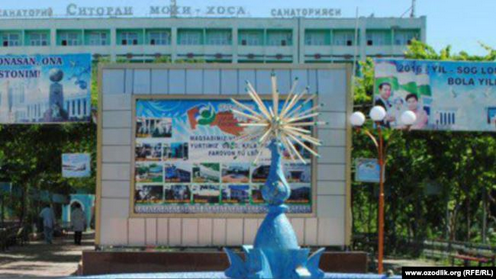 The Sitorai Mohi Khosa Sanatorium in Bukhara, where at the time of the Ozodlik report, 247 Uzbeks who had returned from Turkey were being confined. Photo from RFE/RL
The Sitorai Mohi Khosa Sanatorium in Bukhara, where at the time of the Ozodlik report, 247 Uzbeks who had returned from Turkey were being confined. Photo from RFE/RL
Conditions, Ozodlik writes, varied between different sites. One common criticism of these facilities, however – at least at the start of the epidemic – was that they failed to ensure adequate social distancing and epidemiological hygiene, increasing the risk of infection spreading among internees. At one facility in Surkhondaryo, it was said that 200 people gathered to eat in the canteen at the same time.
Similar conditions held at the Nazarbek sanatorium near Tashkent, Aziz (pseudonym) told RFE/RL:
“We flew from Moscow to Tashkent on 21 March and they immediately sent us to the Nazarbek sanatorium in the Tashkent region. It’s a six-floor building with 1, 2, 3 and 4-bed rooms, like in hotels. But there was no kind of isolation! We ate in a common canteen, with no thought of using disposable plates and cutlery. They gave us bread rolls, pieces of sausage and eggs. Among us there were kids, pregnant women and diabetics. We were unhappy with the food and asked them to give us something decent. The sanatorium was guarded by the military and they all but threatened us at gunpoint.”
Some of those placed in quarantine started to demand that mealtimes take place in isolation. Their requests, Ozodlik writes, fell on deaf ears.
“We tried to call the hotline, but nobody ever answered. And then they confiscated our mobile phones, saying that the virus can survive for a long time on such objects. They shut off the mobile internet. The connection on the sanatorium’s landline was bad too. They really treated us as if we were diseased cattle!” Dilmurod (pseudonym) said angrily.
Similar complaints were voiced by those who were placed in quarantine at the military barracks in Shavat in the Khorezm region.
“People had to sleep close to one another. Everyone ate in the same canteen. Peopled queued to use the toilets. About 20 people on average shared a shower. The drainage was really bad. Staff who were overseeing the quarantine were not wearing masks or gloves,” Azat told RFE/RL.
According to Kamol, who spent time at Nazarbek before being transferred to O’rtasaroy, things there did improve later, with meals delivered direct to residents’ rooms. But this was only after new infections had been discovered among residents, leading to extended stays in quarantine. Kamol said that he had been quarantined for almost a month. When RFE/RL spoke to them, Aziz and Dilmurod had also been transferred from Nazarbek to the container camp at O’rtasaroy. By that point they too had been in quarantine for 25 days.
Replying to criticisms on this subject on news sites and social media, Uzbekistan’s chief medical officer, Nurmat Otabekov, had the following to say:
“People are complaining that we are extending their stay in quarantine. They are writing that they got infected while they were in the initial quarantine. If someone in the risk group gets infected with the virus then he has only himself to blame. He could have protected himself by following safety guidelines and avoiding contact with other people in quarantine.”
Critics responded that this was rather difficult when people were forced to use a common canteen and shared bathrooms.
The “good government, bad local officials” paradigm, again
Another area many interviewees focus on is the plight of those with health conditions. Besides the difficulty of maintaining social distancing and the physical discomfort of some of the accommodation, for some people there was the issue of obtaining much-needed medication. O’rtasaroy resident Abdulla (pseudonym), Svetlana Bagramova writes, suffered from an intensely painful hernia, but his prescription cream ran out back when he too was at the Nazarbek sanatorium, and O’rtasaroy doctors were only able to provide him with basic medication like aspirin and paracetamol. Relatives of Feruze (pseudonym), who is diabetic, spent two days trying to convey to her the medication she needed and succeeded only after turning to contacts in the Tashkent administration for assistance.
As Svetlana Bagramova’s article makes clear, the whole issue of deliveries from friends and family was a murky one. There were no unified rules. Some were refused point blank, with relatives turned away at the checkpoint on the way into O’rtasaroy and forced to carry back home with them the items that their loved ones sometimes badly needed. Others were quoted a price: 400,000 som ($40), say, to pass on a delivery. Or they had to let checkpoint guards take their pick of the contents. Officially, the government’s hotline says that only medication and clothing can be passed on. Yet there were cases where medication was not allowed past the checkpoint, on the grounds that permission was required from a camp doctor.
“Total arbitrariness on the part of the soldiers and the local staff,” wrote one Facebook user. “There are many things they don’t allow relatives to bring to those in the camp. (...) To have a package delivered promptly you have to pay. They don’t even shy away from taking some of the contents – some of the permitted objects disappear along the way. (...) I never saw this side of my native Uzbekistan before, we’re still a long way off from being a civilised society.”
The author of one much-shared post on Potrebitel.uz’s page on Facebook, Islam Hafizov, wrote that residents were informed that deliveries were permitted. “But there’s one ‘but’ – deliveries are possible based on the French system of taxation, in other words guards at the first and second checkpoints shamelessly deduct their share of the contents (indeed the lion’s share).” Islam’s own parents had paid guards $10 to pass on two ten-litre water containers and two kilos of pies and dolmas. Only one water container made it to its destination.
Trade in and speculation on in-demand goods – above all cigarettes and nasvay – on the part of the camp guards was also rife, Islam wrote, along with Grigori Danielyan and others. Anastasia relates that a guy from a neighbouring container who she and her roommates had got to know via the camp landline was able to visit her container by paying a site worker to give him his hazmat suit, allowing him to move around the whole area unhindered. The work of medical staff at the camp, on the other hand, is almost universally praised.
With the combination of poor access to medicine, local officials’ greed, and the onset of summer – recent temperatures in the area have reached 40 degrees – Svetlana Bagramova closes her article by worrying about the fate of the vulnerable in these camps. The elderly, the sick, those who have recently undergone surgery, the disabled and families with small children are first in line for charter flights back to Uzbekistan and will likely have to pass through O’rtasaroy. Their very survival in the camp, she says, could prove difficult. “Not because ‘the government hasn’t done its job’. But because someone has decided they have the right to make a profit on all this. No one can check on the situation inside the camps, and in response to every complaint section leaders reply that no such incident has taken place. It is difficult for camp residents to back up their words with evidence: their phones were thoughtfully confiscated as soon as they stepped off the plane.”
The theme of local officials sabotaging the good intentions of the president and central government is a common one in residents’ reports. Islam Hafizov closes his account with the following: “Thank you to the government and the special commission headed by the President for the opportunities and conditions that are being created to ensure citizens’ return! Just a shame that there is the human factor: local officials in the form of those responsible on-site, who are possibly sabotaging the work of the Special Commission and the President.”
The cliché of benevolent central powers and local corruption, of course, is not limited to Uzbekistan, but it has had a real upsurge with the advent of Shavkat Mirziyoyev. Whether or not it is used here and elsewhere as cover to advance significant concrete critique, though, corruption as a system probably suffers very little...
-
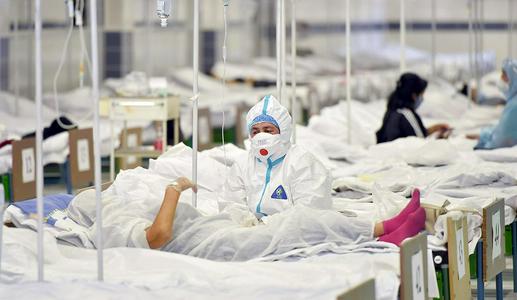 06 August06.08What went wrong in Central Asia’s coronavirus response?How poor planning and a fixation on faulty test results undid months of hard work
06 August06.08What went wrong in Central Asia’s coronavirus response?How poor planning and a fixation on faulty test results undid months of hard work -
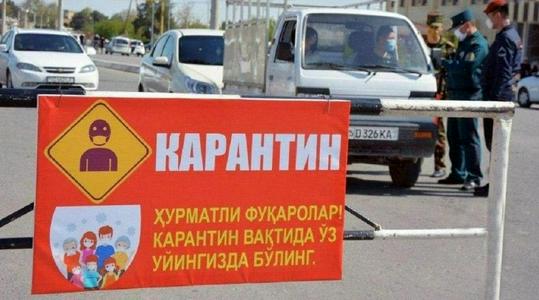 31 July31.07“Another week and I wouldn’t have got out of there alive”Why patients in Uzbekistan fear ending up in hospital, and medics fear the end of the lockdown
31 July31.07“Another week and I wouldn’t have got out of there alive”Why patients in Uzbekistan fear ending up in hospital, and medics fear the end of the lockdown -
 21 July21.07War of worldsThe first public protest action in Uzbekistan in defence of women’s rights met with an aggressive reaction from much of society
21 July21.07War of worldsThe first public protest action in Uzbekistan in defence of women’s rights met with an aggressive reaction from much of society -
 19 May19.05“I felt like a criminal”How Central Asia fought the coronavirus with quarantines – and appears to be winning
19 May19.05“I felt like a criminal”How Central Asia fought the coronavirus with quarantines – and appears to be winning -
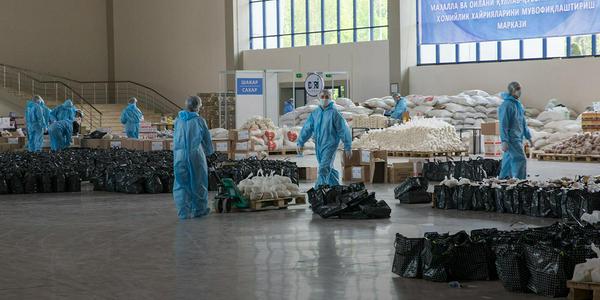 26 April26.04“Generosity and Assistance”The Uzbek government has announced plans to help the public through the coronavirus crisis – with the main role falling to private business
26 April26.04“Generosity and Assistance”The Uzbek government has announced plans to help the public through the coronavirus crisis – with the main role falling to private business -
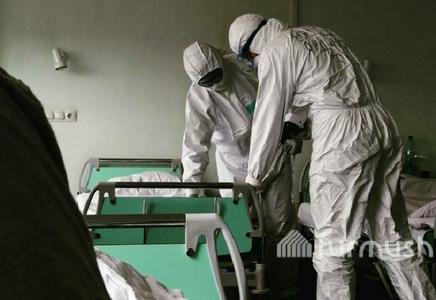 14 April14.04In harm’s wayRates of infection among Central Asian healthcare workers are alarming. Their complaints are rarely welcome
14 April14.04In harm’s wayRates of infection among Central Asian healthcare workers are alarming. Their complaints are rarely welcome
